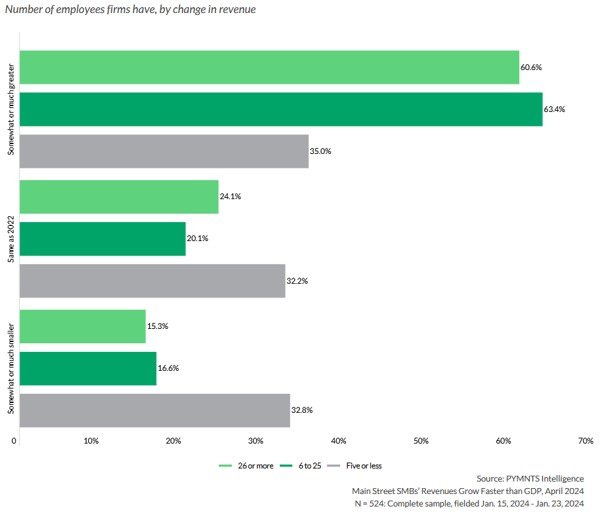33% of Main Street SMBs With 5 or Fewer Staffers Saw Lower Earnings in 2023

Most small to mid-sized businesses (SMBs) located up and down Main Street, USA, are doing just fine, thank you very much.
In fact, according to PYMNTS Intelligence data, business growth and wages for more than half of U.S. Main Street SMBs are outpacing last quarter’s national GDP rate of 5.7%.
Those are just two takeaways from PYMNTS Intelligence’s latest SMB Growth Monitor Report, “Main Street Small Business Growth Exceeds GDP for First Time in Two Years,” which draws on survey data with 524 U.S. Main Street SMBs (earning $10 million or less annually) and other supplemental data.
Overall, the report reveals most Main Street SMBs have experienced steady growth dating back to April 2021. And while SMB growth for 2023 outpaced the GDP, that recent growth spurt actually reversed a two-year trend in which nominal GDP growth outpaced that of SMBs. In 2021, Main Street SMBs reported a 3.2% growth rate while nominal GDP grew by 12%. In 2022, SMBs saw a 5.5% growth rate, while GDP rose 7.1%.
As of January 2024, more than half of Main Street SMBs surveyed reported revenue growth during the previous year. We found this success appears to be especially strong for SMBs operating in the hospitality sector, which reported an 11% increase in revenues in 2023, up from 1.5% in 2022. This suggests post-pandemic consumers may be eager to embrace leisure activities, such as dining out and enjoying vacations.
However, not everything is entirely rosy on Main Street.
While consumers appear to be more comfortable dining out, traveling and staying at hotels in post-pandemic America, work-related businesses on Main Street appear to be facing a more challenging time. Main Street SMBs in the professional services sector are the least likely to report growing revenues, at 30%, suggesting that automation and changing work-related norms impact these SMBs.
Older small businesses appear to be an exception to the growing revenues uplift small businesses are seeing. Those SMBs that have been doing business on Main Street for more than 20 years are experiencing a decline in growth compared to younger businesses. In 2024, just 27% of Main Street SMBs that have been in business for more than two decades reported an increase in revenues. Meanwhile, 67% of Main Street SMBs that have been in business for less than five years reported revenue bumps.
The lack of growth among older businesses suggests that business owners may need to consider innovating their business models to keep pace with current consumer expectations.

But as the chart above illustrates, it’s not just older businesses that saw a drop in revenue. A significant portion of smaller SMBs — at least in terms of their headcounts — also saw a decrease in earnings last year.
The chart — which reflects exclusive PYMNTS Intelligence data that was not included in our original report — confirms that 61% of Main Street SMBs with 26 or more employees saw somewhat or much greater revenue in 2023. Sixty-four percent of companies with 6 to 25 staffers also saw a bump in revenue during that time. However, only 35% of these SMBs with five or fewer employees reported increased revenue. Meanwhile, 1 in 3 SMBs with five or fewer employees reported a drop in revenue in 2023, while only 15% of SMBs with 26 or more employees reported similar earnings reductions.
While sectors such as hospitality continue to grow, some older and smaller SMBs report decreasing revenue and, as a result, continue to struggle. Although it might seem counterintuitive, data suggests that entrepreneurs might be able to overcome that struggle by investing in innovation and adding employees to the payroll.

